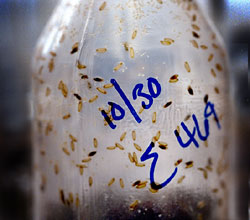
This tiny fly ( Drosophila melanogaster ), about three millimeters long, has been used to study classic genetics and mutations since the early twentieth century. It’s still one of the most important and widely used model organisms for genetics and developmental biology. It has a short life cycle, it’s cheap to buy, easy to raise and handle, and its genome has been completely mapped and sequenced. Fruit fly researchers have a tradition of using whimsical names to describe genetic mutations. For instance, "leonardo" and "dunce" describe two gene variations that affect a fly’s ability to learn new odor tasks. The genes involved in learning in flies are very basic to brain function; humans have similar genes that operate at a cellular level in our brain.
— Tim Tully , Research biologist, Cold Spring Harbor Laboratory
On
why economics is sometimes important in choosing a model organism:
"And the economy of scale applies to the cost in time and resources to do genetics. Flies have a two-week generation cycle, and we can raise thousands for pennies. Mice have a four-month generation cycle, and it costs fifty cents a day per mouse to house them." — Tim Tully , Research biologist, Cold Spring Harbor Laboratory
—
Tim
Tully
, Research biologist, Cold Spring Harbor Laboratory
Purdue University's Interactive Fly provides some developmental information about Drosophila, as well as a genetic reference. Try our online comparison of fruit flies and see how mutations can alter their color and shape! |
||||||

 On
the fruit fly as a model organism for studying the genetics of memory:
On
the fruit fly as a model organism for studying the genetics of memory:
 On
the differences between flies and humans:
On
the differences between flies and humans: